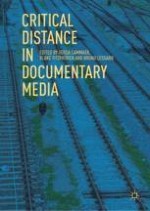2018 | OriginalPaper | Chapter
Approaches to Xianchang: Documenting the Real in Post-socialist China
Author : Madeline Eschenburg
Published in: Critical Distance in Documentary Media
Publisher: Springer International Publishing
Activate our intelligent search to find suitable subject content or patents.
Select sections of text to find matching patents with Artificial Intelligence. powered by
Select sections of text to find additional relevant content using AI-assisted search. powered by
